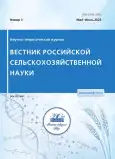Efficiency of tank mixes usage to protect sweet corn from pests
- Authors: Khanieva I.M1, Shibzukhov Z.-.1, Kashukoev M.V1, Magomedov K.G1, Boziev A.L1
-
Affiliations:
- Federal state budgetary educational institution of higher professional education �Kabardino-Balkar State Agrarian University named after V. M. Kokov�
- Issue: No 3 (2023)
- Pages: 24-27
- Section: Articles
- URL: https://journals.rcsi.science/2500-2082/article/view/147898
- DOI: https://doi.org/10.31857/2500-2082/2023/3/24-27
- EDN: https://elibrary.ru/QNGJNJ
- ID: 147898
Cite item
Full Text
Abstract
About the authors
I. M Khanieva
Federal state budgetary educational institution of higher professional education �Kabardino-Balkar State Agrarian University named after V. M. Kokov�
Email: imhanieva@mail.ru
Z. -G.S Shibzukhov
Federal state budgetary educational institution of higher professional education �Kabardino-Balkar State Agrarian University named after V. M. Kokov�
M. V Kashukoev
Federal state budgetary educational institution of higher professional education �Kabardino-Balkar State Agrarian University named after V. M. Kokov�
K. G Magomedov
Federal state budgetary educational institution of higher professional education �Kabardino-Balkar State Agrarian University named after V. M. Kokov�
A. L Boziev
Federal state budgetary educational institution of higher professional education �Kabardino-Balkar State Agrarian University named after V. M. Kokov�
References
- Анцупова Т.Е., Казанок Т.С. Разработка системы защиты сахарной кукурузы против хлопковой совки // Труды Кубанского государственного аграрного университета. 2008. № 13. С. 127-130.
- Анцупова Т.Е. Вредоносность хлопковой совки в агроценозе кукурузы в условиях Ростовской области / Научное обеспечение агропромышленного комплекса. / Сб. статей по мат. 71-й науч.-практ. конф. преподавателей по итогам НИР за 2015 год. Ответственный за выпуск А. Г. Кощаев. 2016. С. 74-75.
- Атаева А.У. Эффективность производства сахарной кукурузы / Проблемы конкурентоспособности потребительских товаров и продуктов питания. / Сб. науч. статей 3-й Межд. науч.-практ. конф. Курск, 2021. С. 56-57.
- Багринцева В.Н., Кузнецова С.В. Хлопковая совка на кукурузе в Ставропольском крае // Защита и карантин растений. 2018. № 7. С. 32-34.
- Багринцева В.Н., Кузнецова С.В., Ивашененко И.Н. и др. Рекомендации по защите кукурузы от хлопковой совки. Пятигорск, 2017.
- Государственный каталог пестицидов и агрохимикатов, разрешенных к применению на территории Российской Федерации. 2020 год (утв. Минсельхозом России) (по состоянию на 06.08.2020).
- Селивёрстова Д.М. Эффективность производства сахарной кукурузы // Аллея науки. 2020. № 2 (41). С. 251-253.
- Сотченко В.С., Багринцева В.Н. Технология возделывания кукурузы // Вестник АПК Ставрополья. 2015. № S2. С. 79-84.
- Тарчоков Х.Ш., Хромова Л.М., Урусов А.К. Провести оценку эффективности биологических и химических препаратов в борьбе с хлопковой совкой на посевах кукурузы // Отчет о НИР (филиал Федерального государственного бюджетного научного учреждения "Федеральный научный центр "Кабардино-Балкарский научный центр Российской академии наук")
- Ханиева И.М., Шибзухов З.С., Шогенов Ю.М. Влияние сортовых особенностей и сроков посева на урожайность сахарной кукурузы в Кабардино-Балкарии // Проблемы развития АПК региона. 2018. № 2 (34). С. 102-108.
- Хромова Л.М., Шипшева З.Л., Хромова Д.А. Как защитить посевы кукурузы от вредных организмов // Защита и карантин растений. 2018. № 12. С. 29-31.
- Шабатуков А.Х., Хромова Л.М. Биологический контроль болезней кукурузы в условиях степной зоны Кабардино-Балкарии // Вестник АПК Ставрополья. 2019. № 3 (35). С. 78-82.
- Шидова Л.Х., Шипшева З.Л., Кимова Д.А., Хромова Л.М. Хозяйственная и экономическая эффективность инсектицидов в борьбе с хлопковой совкой // Аграрная Россия. 2021. № 8. С. 24-27.
- Ezaov A., Shibzukhov Z.G., Shibzukhova Z., Khantsev M., Beslaneev B. Prospects and technology of cultivation of organic vegetable production on open ground in southern russia conditions // E3S Web of Conferences. Сер. "International Scientific and Practical Conference "Development of the Agro-lndustrial Complex in the Context of Robotization and Digitalization of Production in Russia and Abroad", DAIC 2020" 2020. С. 2003.
Supplementary files










